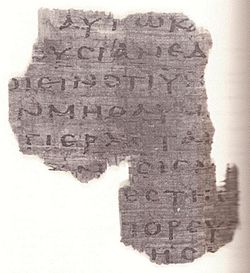Papyrus 95
New Testament manuscript From Wikipedia, the free encyclopedia
Papyrus 95 is an early copy of the New Testament in Greek. It is a papyrus manuscript of the Gospel of John in a fragmentary condition. It is designated by the siglum 𝔓95 in the Gregory-Aland numbering of New Testament manuscripts. The surviving texts of John are verses 5:26-29,36-38. Using the study of comparative writing styles (palaeography), it has been assigned to the early 3rd century.[1]
| New Testament manuscript | |
 John 5:26-29 | |
| Name | P. Laur. PL II/31 |
|---|---|
| Sign | 𝔓95 |
| Text | John 5:26-29,36-38 |
| Date | 3rd century |
| Script | Greek |
| Now at | Universita Degli Studi di Milano |
| Cite | J. Lenaerts, Un papyrus de l’Évangile de Jean : PL II/31, Chronique d’ Egypte 60 (1985), pp. 117-120 |
| Size | [12] x [24] cm |
| Type | Alexandrian text-type |
| Category | I |
Description
The writing is in 35 lines per page.[2] The fragment should have the word πατήρ contracted (known as a nomen sacrum) in two places, however the place where these would appear is missing due to the fragmentary nature of the manuscript.[3] The manuscript is currently housed at the Biblioteca Medicea Laurenziana (PL II/31) at Florence.[4][5]
Text
The Greek text of this manuscript is considered a representative of the Alexandrian text-type. Papyrologist and biblical scholar Philip Comfort describes it as proto-Alexandrian, though the extant portion is too fragmentary for certainty.[2] It has not yet been placed in any of the Categories of New Testament manuscripts.[4]
Textual variants
- 5:27 Word-spacing analysis indicates that 10-14 letters intruded between the first two words of the verse
- 5:28: ακουσουσιν (akousousin, 'shall hear' (future tense)) becomes ακουσαντες (akousantes, 'have heard' (aorist aspect, participle)).
- 5:36: omits second 'αυτα' (auta, these) through possible homoeoteleuton.
See also
References
Images
Further reading
Wikiwand - on
Seamless Wikipedia browsing. On steroids.
